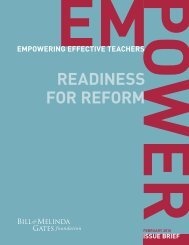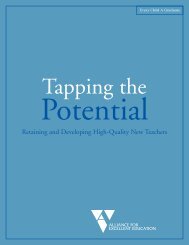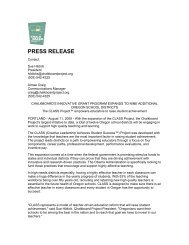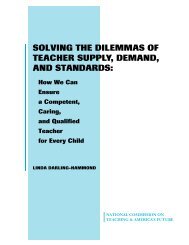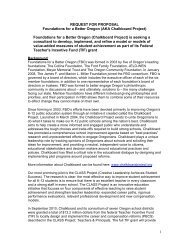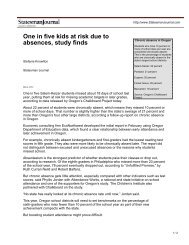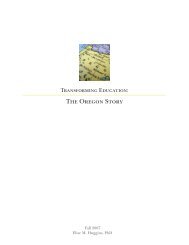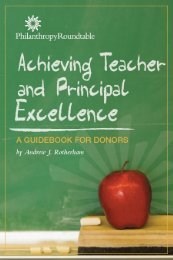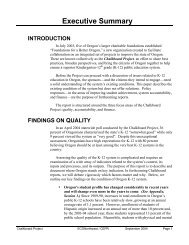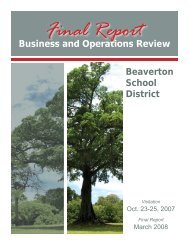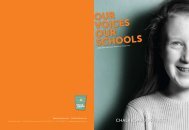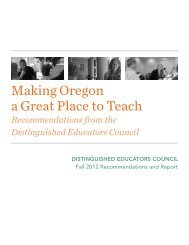Extended Learning Time - The Chalkboard Project
Extended Learning Time - The Chalkboard Project
Extended Learning Time - The Chalkboard Project
You also want an ePaper? Increase the reach of your titles
YUMPU automatically turns print PDFs into web optimized ePapers that Google loves.
A REVIEW OF RESEARCH ON EXTENDED<br />
LEARNING TIME IN K-12 SCHOOLS<br />
DECEMBER 2010<br />
INTRODUCTION<br />
ECONorthwest’s 2008 whitepaper<br />
A Review of Research on <strong>Extended</strong> <strong>Learning</strong><br />
<strong>Time</strong> in K-12 Schools reviewed the then<br />
available literature about extended learning time<br />
(ELT) in kindergarten through twelfth grade. This<br />
update to the whitepaper describes more recent<br />
ELT research and expands on the recommendations<br />
originally presented.<br />
ELT programs seek to improve educational outcomes through<br />
increased student contact time, although ELT implementation can vary<br />
significantly in the details. Efforts typically involve one of two main<br />
approaches: adding hours or days to the regular school schedule using<br />
existing staff and facilities, or implementing out-of-school programs<br />
(after-school or summer school) that are operated separately from the<br />
regular school day or year. But other options have been explored, such<br />
as improving the use of time within the existing school calendar, and<br />
adjusting the calendar to shorten long summer breaks.<br />
<strong>The</strong> literature suggests that the likelihood of success with an ELT<br />
program relies on strong coordination with regular school programs;<br />
employment of highly qualified staff; support from involved families and<br />
the broader community; a focus on a narrow set of outcomes for highrisk<br />
students; and intensive, sustained participation by students.<br />
1. ELT proponents generally propose implementing ELT as a means of<br />
improving academic achievement. Massachusetts 2020, a longtime<br />
supporter of ELT, cites five primary benefits that derive from adding<br />
time to the traditional school day: 1<br />
2. More time on task;<br />
3. Greater depth and breadth of learning;<br />
4. More time for teacher planning and professional development;<br />
5. More time for enrichment and experiential learning; and<br />
6. Stronger relationships between teachers and students.
2 <strong>Extended</strong> <strong>Learning</strong> <strong>Time</strong> in K-12 Schools<br />
However, some ELT skeptics argue that ELT<br />
resources should instead be redeployed to<br />
improving the quality of existing school time<br />
instead to increase classroom time. Others<br />
contend that the resources would provide more<br />
benefits if devoted to other programming already<br />
proven to be cost-effective in improving academic<br />
achievement, such as expanded early-childhood<br />
education opportunities and certain evidencebased<br />
programs for disadvantaged students.<br />
Schools typically implement ELT at the same<br />
time as other reforms, such as professional<br />
development for teachers, mental and physical<br />
health services for students, and new instruction<br />
and academic enrichment content. In addition,<br />
schools use additional learning time in a variety<br />
of ways, with differences in focus, curricular<br />
content, and structure. While this flexibility<br />
allows the school to tailor the program to the<br />
specific needs of its student body, these features<br />
of ELT implementation can present significant<br />
analytical challenges to researchers seeking to<br />
generalize about the beneficial impacts of ELT. 2<br />
<br />
As described in the 2008 whitepaper, researchers<br />
generally find that children from low socioeconomic<br />
backgrounds gain the most from ELT;<br />
that elementary and secondary students gain<br />
more from ELT programs than do middle school<br />
students; and that the effect of out-of-school<br />
learning time does not vary greatly depending<br />
on whether time is added to the regular school<br />
day or through additional school days during the<br />
summer. 3<br />
At present, ELT research remains largely quasiexperimental<br />
and anecdotal, but recent findings<br />
nonetheless continue to add support for the idea<br />
that ELT can improve student outcomes. <strong>The</strong><br />
most compelling research has emerged from<br />
studies of charter schools implementing ELT, in<br />
part because most ELT efforts to date have been<br />
implemented at charter schools:<br />
A 2009 National Center on <strong>Time</strong> and <strong>Learning</strong><br />
survey of 655 expanded-time schools found<br />
that three-quarters of expanded-time schools<br />
are charter schools existing outside of state or<br />
local regulations. A total of 300,000 students in<br />
36 states and the District Columbia attended<br />
these schools, serving a large minority and<br />
poor student body. Almost half of the schools<br />
in the survey started an expanded time<br />
schedule within the last three years. <strong>The</strong> survey<br />
found a statistically significant correlation<br />
between total classroom time and student<br />
performance for grades seven and 10 in both<br />
math and English. 4<br />
A recent analysis of student outcomes for<br />
applicants to all New York City charter schools<br />
between 2000 and 2008 also supports positive<br />
ELT impacts. <strong>The</strong> lottery-based evaluation<br />
compares achievement data of students<br />
admitted to charter schools against data from<br />
students who applied but were not admitted.<br />
<strong>The</strong> study found that a student who attended<br />
a charter school from kindergarten through<br />
eighth grade would, on average, close about 86<br />
percent of the “Scarsdale-Harlem achievement<br />
gap” in math and 66 percent in English. When<br />
analyzing the factors that might contribute<br />
to the closing of the achievement gap, results<br />
found that the strongest predictor of positive<br />
achievement is the longer school year. 5<br />
New York charter schools manage to have<br />
longer school years while operating on a<br />
smaller budget than most regular public<br />
schools. Money saving techniques include<br />
small administrative staffs, younger teaching<br />
staff and slightly larger class sizes. Expanding<br />
class size by a small number of students can<br />
free up a significant amount of budget. 5<br />
While not necessarily feasible in every case,<br />
innovative approaches to financing ELT is<br />
increasingly important as school budgets are<br />
unlikely to grow appreciable for the foreseeable<br />
future.<br />
In parallel with these promising new research<br />
findings, ELT has recently come to the forefront<br />
of the national education reform agenda:<br />
President Barack Obama’s education speech<br />
in March 2009 acknowledged “the challenges
ECONorthwest / <strong>The</strong> <strong>Chalkboard</strong> <strong>Project</strong> 3<br />
of a new century demand more time in the<br />
classroom”. <strong>The</strong> “<strong>Time</strong> for Innovation matters<br />
in Education Act” responded to the president’s<br />
call to action by supporting state initiatives<br />
that expand time by at least 300 hours for lowperforming<br />
schools.<br />
<strong>The</strong> U.S. Secretary of Education Arne Duncan<br />
called for innovative and comprehensive<br />
national education reform, including<br />
expanding school time for underperforming<br />
schools.<br />
<strong>The</strong> 2009 American Recovery and<br />
Reinvestment Act made increased learning<br />
time a key eligibility requirement of the School<br />
Improvement Grants.<br />
<strong>The</strong> U.S. Senate is currently discussing an<br />
increase in funding for the 21st Century<br />
Community <strong>Learning</strong> Centers program by<br />
$100 Million, and making program funds<br />
available for extended learning time and afterschool<br />
programs.<br />
New federal funding opportunities require<br />
that schools use extended learning time. <strong>The</strong>se<br />
opportunities include the ARRA “Race to the<br />
Top” fund, Investing in Innovation fund, and<br />
the School Improvement Grants.<br />
During its 2009 session, the legislature passed<br />
Senate Bill 484. <strong>The</strong> bill set the stage for moving<br />
Oregon schools toward year-round classes and<br />
established a summer instruction pilot program<br />
that was implemented in the Salem-Keizer and<br />
Reynolds school districts. A draft bill that reintroduces<br />
elements of SB 484 with refinements<br />
that reflect findings from the Salem-Keizer and<br />
Reynolds pilot projects is under review for the<br />
2011 session (see appendix).<br />
Recommendations<br />
ECONorthwest’s 2008 white paper recommended<br />
that Oregon school districts test the ELT model<br />
at carefully selected pilot school sites. <strong>The</strong>se<br />
schools would devote the extended time to<br />
specific, proven interventions, including one-onone<br />
tutoring of students at risk of reading failure<br />
or small group monitoring of students at risk of<br />
dropping out of high school.<br />
<strong>The</strong> recent ramping up of federal support for<br />
ELT programs makes this an opportune time<br />
for Oregon to increase experimentation with<br />
ELT. Recently available and prospective funding<br />
sources include:<br />
<strong>The</strong> $4.35 billion allocated to the ARRA<br />
“Race to the Top” fund - a competitive grant<br />
designed to encourage and reward States<br />
that are creating the conditions for education<br />
innovation and reform, including increased<br />
learning time. 6<br />
<strong>The</strong> $650 million allocated for the ARRA<br />
“Investing in Innovation” fund. This fund<br />
awards grants to districts as well as nonprofit<br />
organizations partnering with schools and<br />
districts to scale up evidence-based practices<br />
and programs.<br />
<strong>The</strong> School Improvement Grant program that<br />
aims to transform chronically low-performing<br />
schools. <strong>Extended</strong> learning time is listed among<br />
the key strategies for implementation.<br />
<strong>The</strong> president’s 2011 budget increases funding<br />
for the 21st Century Community <strong>Learning</strong><br />
Centers program by $100 Million, with a<br />
policy that makes funds available for extended<br />
learning time and after-school programs. 7<br />
Regardless of funding source, educators at<br />
pilot sites should also have the flexibility to<br />
create their own approach to ELT, including<br />
updating educational goals, staffing plans, labor<br />
agreements and schedules. This flexibility spurs<br />
innovation and allows schools to find appropriate<br />
solutions to for the unique challenges it may<br />
face. Flexibility also provides an opportunity for<br />
schools to collaborate with external organizations<br />
and find instructional strategies that align core<br />
academics with enrichment, support services,<br />
and family engagement strategies. Partners<br />
may include universities, community-based<br />
organizations, health centers, businesses,<br />
artists, and many others. Such partnerships can<br />
contribute expertise and resources in areas that<br />
schools are not able to provide to augment the<br />
benefits that ELT alone might provide. 8
4 <strong>Extended</strong> <strong>Learning</strong> <strong>Time</strong> in K-12 Schools<br />
ENDNOTES<br />
1.<br />
Faberman, D., & Kaplan, C. (2005). <strong>Time</strong> for a Change:<br />
<strong>The</strong> Promise of <strong>Extended</strong>-<strong>Time</strong> Schools for Promoting<br />
Student Achievement. Boston: Massachusetts 2020.<br />
2.<br />
Rocha, Elena (2008). “Expanded <strong>Learning</strong> <strong>Time</strong> in<br />
Action.” Center for American Progress.<br />
3.<br />
Smith, B., Roderick, M., & Defener, S.C. (2005).<br />
<strong>Extended</strong> <strong>Learning</strong> <strong>Time</strong> and Student Accountability:<br />
Assessing Outcomes and Options for Elementary and<br />
Middle Grades. Educational Administration Quarterly,<br />
41(2), 195-236.<br />
4.<br />
Farbman, David A. (2009) “Tracking an Emerging<br />
Movement: A Report on Expanded-<strong>Time</strong> Schools in<br />
America”. National Center on <strong>Time</strong> & <strong>Learning</strong>.<br />
5.<br />
Hoxby, Caroline M., Sonali Murarka, and Jenny Kang<br />
(2009). “How New York City’s Charter Schools Affect<br />
Achievement.”<br />
6.<br />
United States Department of Education (2009). “Race<br />
to the Top Program Executive Summary.”<br />
7.<br />
Center for American Progress and National Center on<br />
<strong>Time</strong> & <strong>Learning</strong> (2010). “Transforming Schools to<br />
Meet the Needs of Students.”<br />
8.<br />
Traphagen, Kathleen and Christine Johnson-Staub<br />
(2010). Expanded <strong>Time</strong>, Enriching Experiences.<br />
Center for American Progress.
LC 2762<br />
11/22/10 (HRL/ps)<br />
D R A F T<br />
SUMMARY<br />
Requires State Board of Education to encourage increased learning time.<br />
1<br />
2<br />
3<br />
4<br />
5<br />
6<br />
7<br />
8<br />
9<br />
10<br />
11<br />
12<br />
13<br />
14<br />
15<br />
16<br />
17<br />
18<br />
19<br />
20<br />
21<br />
22<br />
23<br />
A BILL FOR AN ACT<br />
Relating to learning time; amending ORS 329.025 and 329.045.<br />
Be It Enacted by the People of the State of Oregon:<br />
SECTION 1. ORS 329.025 is amended to read:<br />
329.025. It is the intent of the Legislative Assembly to maintain a system<br />
of public elementary and secondary schools that allows students, parents,<br />
teachers, administrators, school district boards and the State Board of Education<br />
to be accountable for the development and improvement of the public<br />
school system. <strong>The</strong> public school system shall have the following characteristics:<br />
(1) Provides equal and open access and educational opportunities for all<br />
students in the state regardless of their linguistic background, culture, race,<br />
gender, capability or geographic location;<br />
(2) Assumes that all students can learn and establishes high, specific skill<br />
and knowledge expectations and recognizes individual differences at all instructional<br />
levels;<br />
(3) Provides each student an education experience that supports academic<br />
growth beyond proficiency in established academic content standards and<br />
encourages students to attain aspirational goals that are individually challenging;<br />
(4) Provides special education, compensatory education, linguistically and<br />
culturally appropriate education and other specialized programs to all students<br />
who need those services;<br />
NOTE: Matter in boldfaced type in an amended section is new; matter [italic and bracketed] is existing law to be omitted.<br />
New sections are in boldfaced type.
LC 2762 11/22/10<br />
1<br />
2<br />
3<br />
4<br />
5<br />
6<br />
7<br />
8<br />
9<br />
10<br />
11<br />
12<br />
13<br />
14<br />
15<br />
16<br />
17<br />
18<br />
19<br />
20<br />
21<br />
22<br />
23<br />
24<br />
25<br />
26<br />
27<br />
28<br />
29<br />
30<br />
31<br />
(5) Supports the physical and cognitive growth and development of students;<br />
(6) Provides students with a solid foundation in the skills of reading,<br />
writing, problem solving and communication;<br />
(7) Provides opportunities for students to learn, think, reason, retrieve<br />
information, use technology and work effectively alone and in groups;<br />
(8) Provides for rigorous academic content standards and instruction in<br />
mathematics, science, English, history, geography, economics, civics, physical<br />
education, health, the arts and second languages;<br />
(9) Is structured to provide increased learning time;<br />
[(9)] (10) Provides students an educational background to the end that<br />
they will function successfully in a constitutional republic, a participatory<br />
democracy and a multicultural nation and world;<br />
[(10)] (11) Provides students with the knowledge and skills that will provide<br />
the opportunities to succeed in the world of work, as members of families<br />
and as citizens;<br />
[(11)] (12) Provides students with the knowledge and skills that lead to<br />
an active, healthy lifestyle;<br />
[(12)] (13) Provides students with the knowledge and skills to take responsibility<br />
for their decisions and choices;<br />
[(13)] (14) Provides opportunities for students to learn through a variety<br />
of teaching strategies;<br />
[(14)] (15) Emphasizes involvement of parents and the community in the<br />
total education of students;<br />
[(15)] (16) Transports children safely to and from school;<br />
[(16)] (17) Ensures that the funds allocated to schools reflect the uncontrollable<br />
differences in costs facing each district;<br />
[(17)] (18) Ensures that local schools have adequate control of how funds<br />
are spent to best meet the needs of students in their communities; and<br />
[(18)] (19) Provides for a safe, educational environment.<br />
SECTION 2. ORS 329.045 is amended to read:<br />
[2]
LC 2762 11/22/10<br />
1<br />
2<br />
3<br />
4<br />
5<br />
6<br />
7<br />
8<br />
9<br />
10<br />
11<br />
12<br />
13<br />
14<br />
15<br />
16<br />
17<br />
18<br />
19<br />
20<br />
21<br />
22<br />
23<br />
24<br />
25<br />
26<br />
27<br />
28<br />
29<br />
30<br />
31<br />
329.045. (1)(a) In order to achieve the goals contained in ORS 329.025, the<br />
State Board of Education shall regularly and periodically review and revise<br />
its Common Curriculum Goals, performance indicators and diploma requirements.<br />
(b) [This includes] <strong>The</strong> review and revision conducted under this<br />
section shall:<br />
(A) Include Essential <strong>Learning</strong> Skills and rigorous academic content<br />
standards in mathematics, science, English, history, geography, economics,<br />
civics, physical education, health, the arts and second languages. [School<br />
districts and public charter schools shall maintain control over course content,<br />
format, materials and teaching methods. <strong>The</strong> regular review shall]<br />
(B) Involve teachers and other educators, parents of students and other<br />
citizens and [shall] provide ample opportunity for public comment.<br />
(C) Strive to find ways to encourage increased learning time. As<br />
used in this subparagraph, “increased learning time” means a schedule<br />
that encompasses a longer school day, week or year for the purpose<br />
of increasing the total number of school hours available to provide:<br />
(i) Students with instruction in core academic subjects, including<br />
mathematics, science, English, history, geography, economics, civics,<br />
the arts and second languages;<br />
(ii) Students with instruction in subjects other than the subjects<br />
identified in sub-subparagraph (i) of this subparagraph, including<br />
health and physical education;<br />
(iii) Students with the opportunity to participate in enrichment<br />
activities that contribute to a well-rounded education, including<br />
learning opportunities that may be based on service, experience or<br />
work and that may be provided by entering into partnerships with<br />
other organizations; and<br />
(iv) Teachers with the opportunity to collaborate, plan and engage<br />
in professional development within and across grades and subjects.<br />
(c) Nothing in this subsection prevents a school district or public<br />
[3]
LC 2762 11/22/10<br />
1<br />
2<br />
3<br />
4<br />
5<br />
6<br />
7<br />
8<br />
9<br />
10<br />
11<br />
charter school from maintaining control over course content, format,<br />
materials and teaching methods.<br />
(2) <strong>The</strong> State Board of Education shall continually review and revise all<br />
adopted academic content standards necessary for students to successfully<br />
transition to the next phase of their education.<br />
(3) School districts and public charter schools shall offer students instruction<br />
in mathematics, science, English, history, geography, economics,<br />
civics, physical education, health, the arts and second languages that meets<br />
the academic content standards adopted by the State Board of Education and<br />
meets the requirements adopted by the State Board of Education and the<br />
board of the school district or public charter school.<br />
12<br />
[4]



